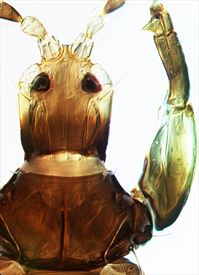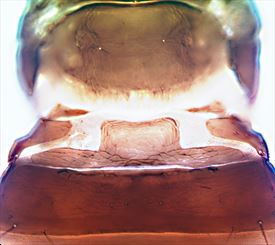Distinguishing features
Female fully winged (or micropterous). Body dark brown with contrasting yellow markings: thorax, abdomen, posterior half of head, and median area of vertex dark brown; anterior half of head yellow, but with interantennal projection pale brown; legs brown, femora sharply yellow in distal half, particularly on inner surface; antennae brown, but segments I and II and pedicels of III-VI yellow; major setae brown; fore wings deeply shaded, with a longitudinal darker line medially. Head almost as wide as long, projecting in front of eyes, narrower at base, weakly sculptured at posterior margin; eyes large, but reduced on ventral surface; ocelli well developed; postocular setae long, finely acute; postocellar setae each arising just behind an ocellus; maxillary stylets almost parallel, about half of head width apart, retracted to compound eyes. Antennae 8-segmented; segments V–VII each with a distinct pedicel; segment VIII not sharply constricted to VII; segment III with 2 long, slender sense cones, segment IV with 4. Pronotum transverse, weakly sculptured on posterior margin; major setae pointed; anteromarginal setae reduced; epimeral sutures complete; basantra present. Mesopresternum broadly boat-shaped. Metanotum elongate, with a reticulate pattern laterally, a pair of small setae medially, and 3 pairs of smaller setae on anterolateral margin; metathoracic sternopleural sutures reaching halfway between middle and hind coxae. Fore tarsal tooth absent. Fore wing almost parallel-sided, scarcely constricted medially; no duplicated wing cilia; 3 major sub-basal setae, S2 arising posterior to S1 and S3. Pelta entire, with broad lateral lobes and a square median lobe that is weakly reticulate medially; tergites III–VII with sigmoid wing retaining setae, tergite II with a slightly curved pair; lateral abdominal setae finely acute; tergite IX posteromarginal setae much shorter than tube; tube shorter than head, slender, anal setae shorter than tube. Micropterous female with median area of vertex and interantennal projection usually yellow, wing lobe brown; ocelli smaller; pronotal anteroangular setae longer; metanotum transverse, faintly reticulate medially; metathoracic sternopleural sutures reaching almost to hind coxae; fore wing lobe scarcely longer than wide, usually bearing 1 long seta; abdomen with pelta lobes smaller; wing-retaining setae reduced.
Male microptera similar to female; fore tarsal tooth large in large males; fore femora swollen, and fore tibiae bent at a slight angle.
Related species
The genus Nesothrips includes 31 species, of which 6 are endemic to New Zealand, 13 are from Australia, 9 described from various Pacific islands, and 3 from southeast Asia. Nesothrips species usually have a rather short head, with a pair of setae between the hind ocelli, and the maxillary stylets wide apart. Unlike many Nesothrips species, H. pintadus appears not to be associated with grasses. There is little variation in body size, although the species has been collected from widely separate localities.
Biological data
Feeding on fungal spores on dead branches.
Distribution data
Known only from New Zealand (BP, TK/NN).
Family name
Family: Phlaeothripidae, Idolothripinae
Species name
Nesothrips pintadus Mound & Walker
Original name and synonyms
Nesothrips pintadus Mound & Walker, 1986: 31
References
Mound LA & Walker AK (1986) Tubulifera (Insecta: Thysanoptera). Fauna of New Zealand 10: 1–140.


